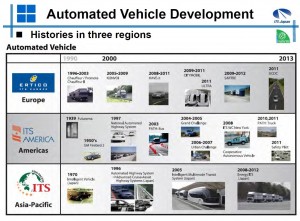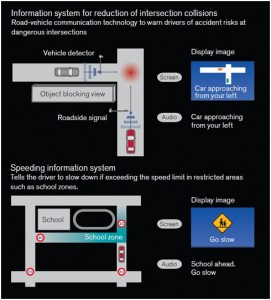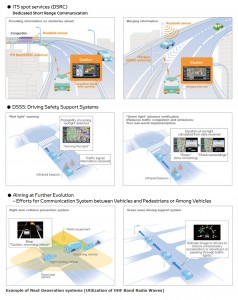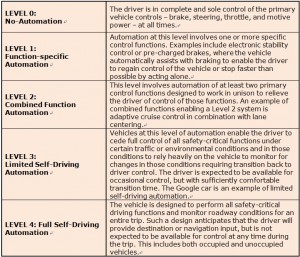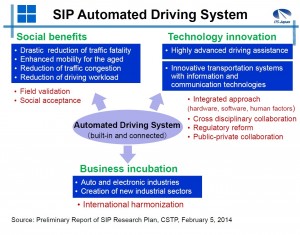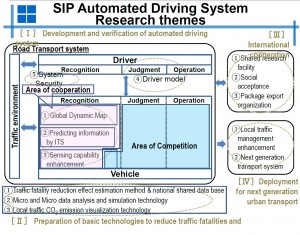Kikuo Hayakawa, NOST Tokyo
Origineel gepubliceerd op de site van RVO.
Samenvatting
Meer dan 90% van alle verkeersongelukken wordt veroorzaakt door menselijke fouten. Zelfsturende auto’s moeten het aantal ongelukken gaan verminderen. Automatische besturingssystemen vormen de kerntechnologie van zelfsturende auto’s.
Japan wil tegen 2020 qua verkeersveiligheid nummer één in de wereld zijn. Het is nu al twintig jaar één van de leidende landen in technologieën voor intelligente transportsystemen (ITS). ITS heeft als doel verkeerscongestie en ongelukken terug te dringen.
Actieve cruise-control- en antibotsingsystemen
De ultieme ambitie van ITS is zelfsturende auto’s. Japanse autofabrikanten, zoals Toyota, Nissan en Honda, hebben antibotsingssystemen en actieve cruise-controlsystemen ontwikkeld. Deze systemen passen de snelheid van de auto aan aan de snelheid van de auto voor u.
Lancering nieuwe auto
In mei 2014 startte in Japan een nieuw project met zelfsturende auto’s in het kader van het nieuwe SIP (Cross-Ministerial Strategic Innovation Promotion Program). Dr. Hiroyuki Watanabe, voorzitter van ITS Japan, gaat dit 3 jaar durende project leiden.
Het doel is om een nieuwe auto te lanceren met een zeer geavanceerd systeem, dat de bestuurder assisteert bij het autorijden. Tegen 2017 kunnen dan innovatieve transportsystemen in productie worden genomen. In 2020 moet de volledig zelfsturende auto op de weg een feit zijn.
Details
The twentieth ITS (Intelligent Transport Systems) World Congress was held in Tokyo from October 14 to 18, 2014, joined by 21,000 participants from 69 countries. At the ITS World Congress there were major discussions mentioning automated and connected vehicles which will significantly contribute to safety, efficiency and driver’s load reduction, and which will be implemented while maintaining the driver’s responsibility under certain conditions such as driving on highways or parking lots by 2020.1 Since 1990, different types of automated vehicles have been developed in three regions including Japan (fig.1). A recent Japanese project, Energy ITS, developed a corporative truck system (platooning) funded by NEDO (New Energy and Industrial Technology Development Organization) between 2008 and 2012.2
Figure 1. Histories of Automated Vehicles (source: ITS Japan)
ITS
Japan is one of the leading countries in ITS. For twenty years, the Japanese government has promoted the development of ITS technologies, aiming to reduce traffic congestion and accidents. Japanese auto makers, such as Toyota, Nissan and Honda, have developed driver assistant systems such as crash avoidance systems and adaptive cruise control systems. Driver assistant systems consist of five driving stages: Parking, Active Safety, Pre-Collision Safety, Passive Safety and Rescue (fig.2).3 In Japan, based on systems using vehicle-to-infrastructure communication technologies, drivers can receive traffic information to avoid collisions or traffic congestion on roads and highways (fig.3, fig.4).2 Also available in Japan is driver information on remaining time for a red light turning green at intersections, using Toyota’s car navigation systems. At the ITS World Congress in Tokyo the above mentioned and already commercialized systems as well as the next generation systems were demonstrated. One of the next generation systems shown was traffic information on the public road which drivers can receive at traffic lights, including a target speed for drivers to avoid having to stop at an intersection. This technology will reduce traffic congestion (fig.4). And innovative safety driving support systems were demonstrated and verified in Hiroshima, mentioning the world’s first vehicle-to-tram cooperative systems co-developed by University of Tokyo, Mazda Motor, Hiroshima Electric Railway and National Traffic Safety and Environment Laboratory (fig.5).4,5 Hiroshima City is well networked with trams on major roads. This project aimed to improve the safety of vehicles and trams on their shared roads, and to reduce traffic congestion caused by vehicles driving ahead of a tram.
Figure 2. Advanced Driver Assistant Systems (source: Toyota)
Figure 3. Advanced Driver Assistant Systems (DSSS) (source: Nissan)
Figure 4. Vehicle-Infrastructure Cooperative Systems that support driving (source: Toyota)
Figure 5. Vehicle-Tram Cooperative Systems (source: Mazda, ITS Japan)
Autonomous Driving
Last year at the ITS World Congress Tokyo and the Tokyo Motor Show, autonomous vehicles were demonstrated on public roads by Japanese automakers such as Toyota, Honda and Nissan. According to ITS Japan, the social interest in autonomous vehicles is increasing in Japan. In the US, Google’s Self-Driving Car has been developed with automakers including Toyota, and tested on public roads in Nevada and other states. In Japan, autonomous vehicles will possibly be launched on highways, prior to introduction on urban roads, due to the different road environments (fig. 6). The Japanese government aims to reduce the number of traffic fatalities to 2,000 or less in 2018 and to become the safest country on roads by 2020.6 In Japan, in fact, the number of fatalities has decreased by more than 50% in the past twenty years. Fatality numbers of drivers and pedestrians aged 65 or older are on the rise (fig.7).
More than 90% of all traffic accidents are caused by human error.7 Therefore, autonomous vehicles are expected to contribute to the reduction of traffic accidents. Japan has started a new project on automated driving systems through the Cross-Ministerial Strategic Innovation Promotion Program (SIP) in May 2014 (fig. 8).1 The three-year project, led by Dr. Hiroyuki Watanabe, chairman of ITS Japan, aims to launch a new vehicle with highly advanced driving assistance systems and innovative transportation systems using ICT in 2017. The project consists of 29 research themes categorized in four topics (fig.9):
- Development and verification of automated driving system;
- Preparation of basic technologies to reduce traffic fatalities and congestion;
- International cooperation;
- Deployment for next generation urban transport.
The project’s research centers will be open to international organizations. The budget is 177 million euro for the first year (2014)*. For this project, Dr. Watanabe has been assigned responsibility for the budget management under the new framework of SIP by the Cabinet Office.8 Japanese auto- and auto parts makers have been developing the applications, such as sensors for autonomous vehicles designed to maintain a proper distance from other vehicles on the road. Toyota is the top runner filing 4,864 patent applications, followed by Denso (2,655 patent applications), German Bosch (2,176), Nissan (1,744) and Honda (1,539).9 Denso is a Japanese auto parts maker joining the Toyota group. To achieve autonomous driving, there are different views by Japanese companies. Toyota’s goal of automated driving is to establish a comfortable relationship, such as between a horse and its rider. Honda aims to secure its concept: fun to drive, fun to use, for autonomous driving as well. Nissan aims to realize a crash-free vehicle based on electricity and intelligence.10 US National Highway Traffic Safety Administration (NHTSA) defines vehicle automation on five different levels (table 1).11 Full automated driving vehicles belong to level 4. Google’s Self-Driving Car belongs to level 3. This SIP project aims to achieve level 2 by 2017. It will follow the next targets: level 3 by early 2020 and level 4 by late 2020.
Figure 6. Autonomous Driving (source: Nissan)
Figure 7. Traffic fatalities in Japan (source: ITS Japan)
Table 1. Definition of Vehicle Automation (source: NHTSA)
Figure 8. SIP Automated Driving System (source: ITS Japan, CSTP)
Figure 9. SIP Automated Driving System (source: ITS Japan)
*) Currency:
1 euro = 138 yen (as of June 18, 2014)
Sources:
1) Automated Driving System – up to date information from japan, Hiroyuki Watanabe, ITS Japan
2) Japan: Intelligente Transport Systemen in de logistiek, RVO article August 2013
3) Toyota ITS
4) Mazda ASV-5 & Tram demonstration in Hiroshima
5) Mazda – Innovaative ASV Demonstration in Horoshima
6) Cabinet Office – R&D Plan, SIP automated driving project May 23, 2014 (in Japanese)
8) Science and Technology Policy, CSTP, Cabinet Office
9) Nikkei Asian Review – Japan big in patents for automated driving, robotics

